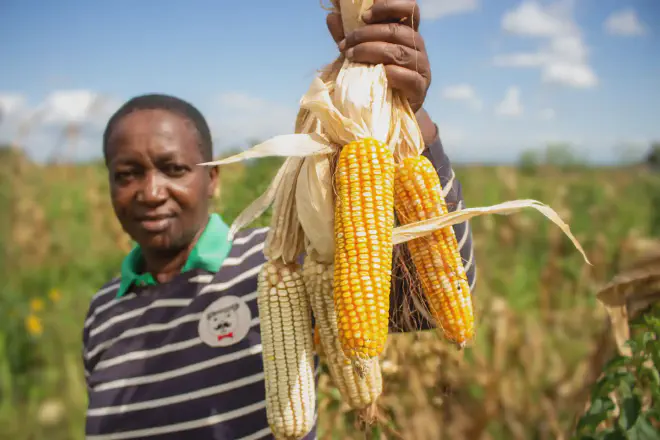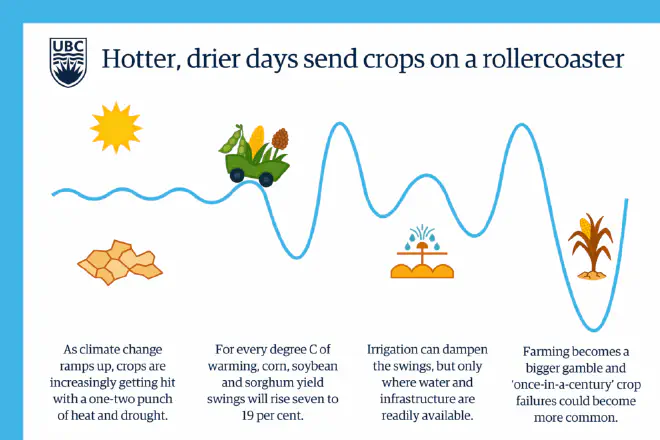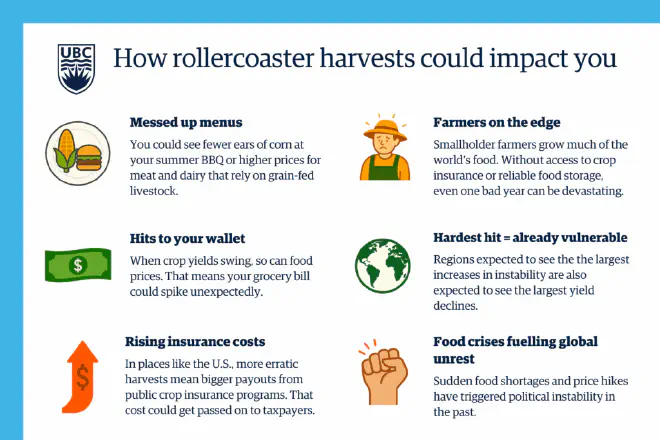

From corn chips to tofu, climate change is messing with the menu, wrote Sachi Wickramasinghe in UBC’s news section.
For some, it may mean pricier burgers; for others, it can bring financial strain and hunger.
Published in Science Advances, the study is the first to show at a global scale how climate change is affecting yield swings of three of the world’s most important food crops: corn, soybean and sorghum.
While previous research has focused on climate-driven declines in average yields, this study highlights a compounding danger: instability.
For many farmers, those swings aren’t abstract. They’re the difference between getting by and going under.
Boom, bust, repeat #
While average yields may not plummet overnight, as year-to-year swings grow, so does the chance of ‘once-in-a-century’ crop failures, or very poor harvests.
If emissions continue to grow, soybean failures could hit as often as every eight years by 2100.
Some of the regions most at risk are also the least equipped to cope, including parts of Sub-Saharan Africa, Central America and South Asia, where many farms rely heavily on rainfall and have limited financial safety nets.
The consequences won’t be limited to lower-income regions. In 2012, for example, a drought and heatwave in the U.S. Midwest caused corn and soybean yields to drop by a fifth, costing the U.S. billions and sparking concern in markets around the world. Within months, global food prices jumped nearly 10 per cent.
Double trouble #
To understand how these overlapping stresses affect crops at a global scale -continued Wickramasinghe-, the researchers combined global harvest records with high-resolution measures of temperature and soil moisture from stations, satellites and climate models.
“A key driver of these wild swings? A double whammy of heat and dryness, increasingly arriving together,” said Dr. Proctor.
“If you’re hydrated and go for a run your body will sweat to cool down, but if you’re dehydrated you can get heatstroke,” said Dr. Proctor. “The same processes make dry farms hotter than wet ones.”
Even brief spells can slash yields in these conditions—disrupting pollination, shortening growing seasons and stressing plants beyond recovery.
For soybeans and sorghum in particular, the growing overlap between heat and moisture explains a large portion of the increase in volatility.

Irrigation can help—if water is available #
Irrigation can effectively reduce yield instability, the study shows, where irrigation water is available. Many of the most at-risk regions, however, already face water shortages or lack irrigation infrastructure.

“Not everyone grows food, but everyone needs to eat,” said Dr. Proctor. “When harvests become more unstable, everyone will feel it.”
The study was co-authored with Lucas Vargas Zeppetello (University of California, Berkeley), Duo Chan (University of Southampton), and Peter Huybers (Harvard University).
Citation #
- The paper Climate change increases the interannual variance of summer crop yields globally through changes in temperature and water supply was published in Science Advances. Authors: Jonathan Proctor, Lucas Vargas Zeppetello, Duo Chan & Peter Huybers
Climate change increases the interannual variance of summer crop yields globally through changes in temperature and water supply Jonathan Proctor https://orcid.org/0000-0001-8053-8828, Lucas Vargas Zeppetello https://orcid.org/0000-0002-4983-0510, Duo Chan https://orcid.org/0000-0002-8573-5115, and Peter Huybers https://orcid.org/0000-0002-3734-8145Authors Info & Affiliations Science Advances 3 Sep 2025 Vol 11, Issue 36 DOI: 10.1126/sciadv.ady3575
Acknowledgments #
The authors thank seminar participants at Harvard University, the University of British Columbia, and the American Geophysical Union Annual Meeting for helpful feedback.
Funding #
L.V.Z. was supported by the James S. McDonnell Foundation and the USDA Hatch Multistate Project WERA102 capacity fund and also thanks the Harvard University Center for the Environment for additional support. P.H. was supported by the Harvard Data Science Initiative and Amazon Web Services.
- The article Climate change is making rollercoaster harvests the new normal signed by Sachi Wickramasinghe was published in UBC’ news section.
Contact [Notaspampeanas](mailto: notaspampeanas@gmail.com)

